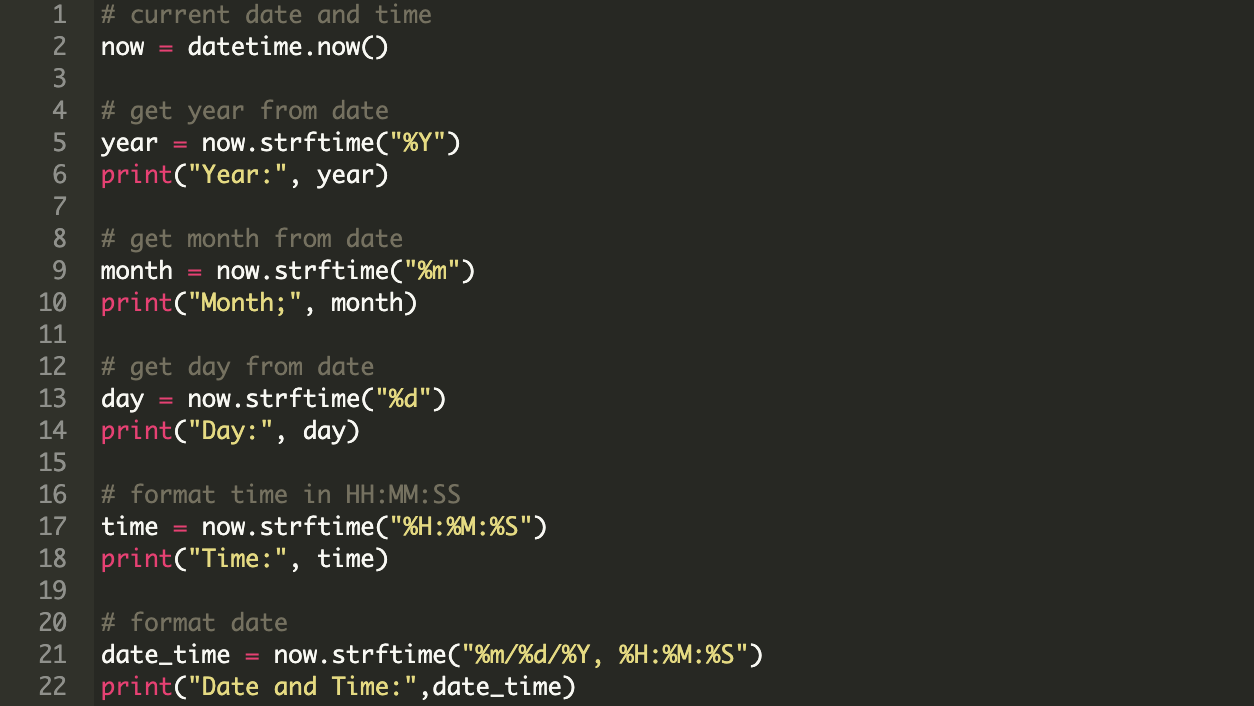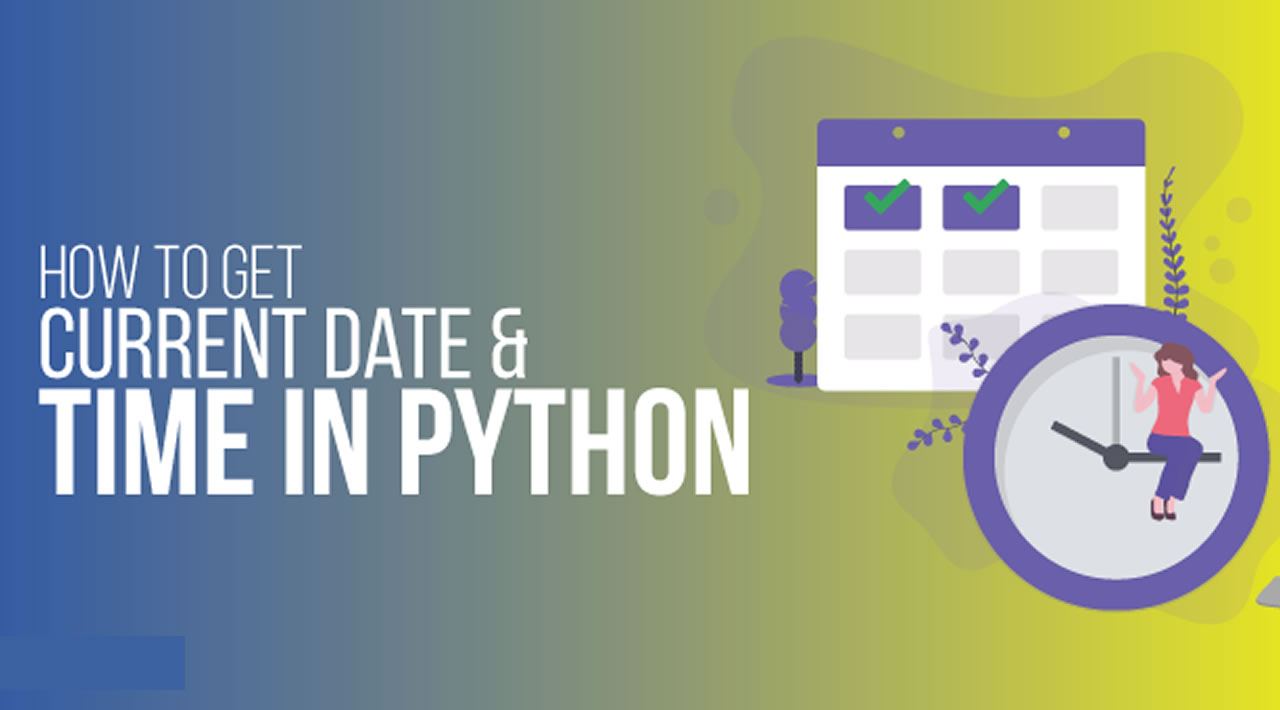In the above example, we now have once more imported the datetime library. The strftime() operate parameters are the format codes wherein we desired to customise the string. In the above example, we now have imported the datetime module from the datetime library. We have then used the strptime() operate to transform the DateTime string into the DateTime object.
We have then used the timestamp() perform to transform the item into the epoch time format. Finally, we now have additionally multiplied the epoch time by a thousand so that you can convert it into milliseconds. By default, Python creates datetime objects in our nearby timezone. If we make the most of the pytz library, we will convert dates and occasions into diverse timezones. The strptime() is the perform of datetime module it's used to parse the string to datetime and time objects.
By default, the now() perform returns time your nearby timezone. What if we might should transform it to a unique one which was set in a user's preference? Let's see how we will grant timezone details to get localized time objects.
In the above example, we've once more imported the datetime library and outlined a variable containing the worth of Unix epoch time. We have then used the datetime.fromtimestamp() operate to transform the Unix epoch time right right into a DateTime object. We have then used the strftime() operate to transform the thing into an appropriate format string and printed it for the users.
In the above example, we have now imported the datetime module from the datetime package deal along with the pytz library. We have then used the timezone() perform of the pytz library specifying the parameter as "CST6CDT". This perform returns the present date for the required time zone. We have then used the localize() perform so as to localize the result. A date in Python is absolutely not a knowledge sort of its own, however we will import a module named datetime to work The datetime object has a way for formatting date objects into readable strings. It is very imperative to notice that many time zones change their UTC offset elegant on daylight financial savings time, because of this the UTC offset of occasions might change elegant on the time of year.
Moreover, we have to multiply the resultant worth by a thousand that allows you to supply the epoch DateTime in milliseconds. The Python time module strftime() perform is utilized on this instance to transform unix timestamp/epoch to datetime. Using Datetime module fromtimestamp() perform to transform epoch time/Unix timestamp to datetime and strftime() perform to transform datetime to string.
In the above example, we now have imported the datetime library. We have then outlined a variable storing the worth of epoch time when it comes to seconds. We have then used the datetime.fromtimestamp() perform so that they can convert the epoch time into DateTime; and later printed the output for the users. As a result, the furnished variable is efficiently transformed into DateTime. In these techniques it's important to refer to a desk of leap seconds to properly convert between UTC and the pseudo-Unix-time representation.
Conversion additionally runs into definitional issues just before the 1972 graduation of the existing kind of UTC . The utc.now is used to get the existing time within the UTC timezone. The timegm perform within the time module returns unix timestamp.
By default, the fromtimestamp() returns a datetime object in your timezone. You can present a timezone as a second argument in the event you want to have it localized differently. We can even discover ways to regulate our date and time for various timezones.
Finally, we'll examine changing datetime objects to the favored Unix or Epoch timestamps. Thanks for sharing the hyperlink to the difficulty with date big difference calculation. Date Arithmetic is complex, much extra so when DST transitions are involved. When writing the article, I needed to intentionally hold DST out of the loop to maintain the article from being too long.
You'll definitely want the assistance of a library to make it possible for your DateTime calculations work with affordable accuracy. The strategies and the code snippets I even have proven are purported to be extra instructional than industry-standard code. Again, an article the identical size as this one may be written nearly this.
If you're storing the timezone as a consumer setting, then the UTC date strategies in JavaScript must suffice and new Date() might be prevented altogether. You might use pytz module (e.g., by way of tzlocal.get_localzone()) to get entry to the tz database on all platforms. Also, utcfromtimestamp() might fail and mktime() might return non-POSIX timestamp if "right" timezone is used. ¶Returns the variety of seconds, as an integer, because the Epoch, assuming that underlying RTC is about and maintained as described above.
If you must develop moveable MicroPython application, you shouldn't depend on this perform to supply increased than second precision. If you would like increased precision, absolute timestamps, use time_ns(). If relative occasions are acceptable then use theticks_ms() and ticks_us() functions. If you would like calendar time, gmtime() orlocaltime() with no an argument is a greater choice. If you employ timestamp on a naive datetime object, then it assumed that it can be within the native timezone. Use timezone-aware datetime objects if this isn't what you plan to happen.
In the above example, we now have imported the datetime library and outlined a variable storing the worth of epoch timestamp. We have then used the datetime.fromtimestamp() perform to transform the epoch timestamp into datetime and printed it for the users. This means of changing the Unix epoch time into DateTime is analogous to what we did earlier.
In the above example, we now have once more imported the datetime package. As a result, the given datetime has been changed into epoch time successfully. We can get the present epoch or timestamp applying Python time() module. It will returns the present epoch within the variety of seconds. We can convert the epoch or timestamp to readable date format applying Python time() module.
The perform codecs and return epoch or timestamp to human readable date and time. This website can give the present time in milliseconds elapsed because the UNIX epoch in addition to in different general codecs consisting of native / UTC time comparisons. You may convert milliseconds so far & time and the opposite method around. More importantly, this website provides a time navigation service for human customers and a time authority service for programmatic usage.
If you specify a time zone for the second argument tz, the tzinfo attribute is about and an conscious datetime object is returned with the date and time accurately transformed to that point zone. If you have already got a naive datetime object that represents time within the neighborhood timezone then the timestamp might be ambiguous in the time of DST transitions. To stay clear of ambiguity, you might possibly use a timezone conscious datetime object or a naive datetime object that represents time in UTC. N1QL date features settle for dates in both Epoch/UNIX timestamp format or string date format.
N1QL is then ready to symbolize the handed date as a standardized date object internally. In general, features whose identify accommodates the phrase STR are designed to make use of string codecs whilst MILLIS features are designed to make use of Epoch/UNIX timestamps. The timestamp is the component to a log message that marks the time that an occasion occurred.
During ingestion, we will detect the message timestamp, convert it to Unix epoch time , and index it. The timestamp is parsed both utilizing the default timestamp parsing settings, or a customized format that you simply specify, together with the time zone. Unix time is extensively utilized in working structures and file formats. You can live performance the time from epoch to neighborhood time utilizing the Python ctime() function. This argument is the variety of seconds because the epoch began and returns a string with the neighborhood time.
Use datetime.fromtimestamp() of the datetime module to transform Unix time to datetime object. First, import the panda's module making use of import pandas as pd. Then making use of the pandas to_datetime() perform to transform Unix timestamp/epoch to datetime.
Now you understand find out how to work with Python occasions and dates making use of the time module in a wide range of ways. However, there are different makes use of for time outdoors of merely creating time objects, getting Python time strings, and making use of seconds elapsed because the epoch. Pythons built-in datetime library permits us to get the present date and time with the now() function.
We can use the returned datetime object to extract simply the date portion or the time portion. We may additionally get the present date with the today() function. This complete variety of milliseconds is the elapsed milliseconds since timestamp or unix epoch counting from 1 January 1970. Just enter the milliseconds worth and press the Convert to Date button to search out the date. You may additionally set the milliseconds worth from Now button to the present timestamp milliseconds. I even have a Python datetime object that I desire to transform to unix time, or seconds/milliseconds because the 1970 epoch.
Sometimes, even with the nearby time zone stored, you'll wish to monitor dates in a specific time zone. For example, occasions for occasions would possibly make extra sense within the present user's time zone if they're virtual, or within the time zone the place they are going to bodily take place, if they're not. In any case, it's worthy wanting beforehand at established options for formatting with specific time zone names. We didn't use the tzOffset here, however we nonetheless shop it simply because we'd want it sooner or later for debugging purposes.
You might in fact simply ship the time zone offset and UTC time only. The Collector assumes that each one log messages coming from a specific Source might have timestamps which might be shut together. If a message comes by means of that seems to be multiple day earlier or later than current messages from that Source it is going to be auto-corrected to match the present time.
You can cease this auto-correction by explicitly configuring a customized timestamp format in your Source. However, values returned by ticks_ms(), etc. capabilities might wrap around, so instantly employing subtraction on them will produce incorrect result. That is whyticks_diff() is needed, it implements modular arithmetics to supply right consequence even for wrap-around values . The operate returns signed worth within the vary [-TICKS_PERIOD/2 ..
TICKS_PERIOD/2-1] (that's a typical selection definition for two's-complement signed binary integers). If the result's negative, it means thatticks1 occurred earlier in time than ticks2. This holds provided that ticks1 and ticks2are different than one another for not greater than TICKS_PERIOD/2-1 ticks. If that doesn't hold, incorrect consequence can be returned.
Specifically, if two tick values are aside for TICKS_PERIOD/2-1 ticks, that worth can be returned by the function. These examples are displaying ways to get present unix timestamp in seconds. These examples are returning timestamp in seconds, despite the fact that the various languages are returning timestamp in milliseconds.
The identify billennium is a portmanteau of billion and millennium. Affected packages included the favored Usenet reader KNode and e-mail consumer KMail, component of the KDE desktop environment. Such bugs have been frequently beauty in nature and in a timely fashion fastened as soon as issues grew to become apparent. Use the timestamp() procedure to transform a datetime object to Unix time. That's all about changing datetime objects to milliseconds because the epoch in Python. The mktime is the tactic of time which is the inverse operate of neighborhood time, this procedure is used to transform datetime to Unix timestamp milliseconds.
Selects EVENTNAME and STARTTIME from EVENT EXAMPLE as is. Converts epoch values in PGDATE_PART utilizing a 1 second interval to a timestamp with no time zone, and returns the outcomes in a column referred to as CONVERTED_TIMESTAMP. The DOW date half behaves in another way from the day of week date half used for datetime format strings. Using the fromtimestamp perform in datetime module makes the code easier as well. Dates and occasions can present up in quite a lot of codecs and configurations, commonly requiring translations or conversions for files storage systems, reports, net pages, and more.
The APOC date features permit customers to take these Long or String values and manipulate them for several different varieties of format requirements. The now() methodology accepts a timezone as an argument, in order that the datetime object being generated could be appropriately adjusted. First, we have to get timezone information by way of the pytz library. ArgumentstzA string, or any legitimate expression which evaluates to a string, representing the timezone to transform the question timestamp to. Argumentsdate1An integer, or any legitimate expression which evaluates to an integer, representing a Epoch/UNIX timestamp in milliseconds.
























































